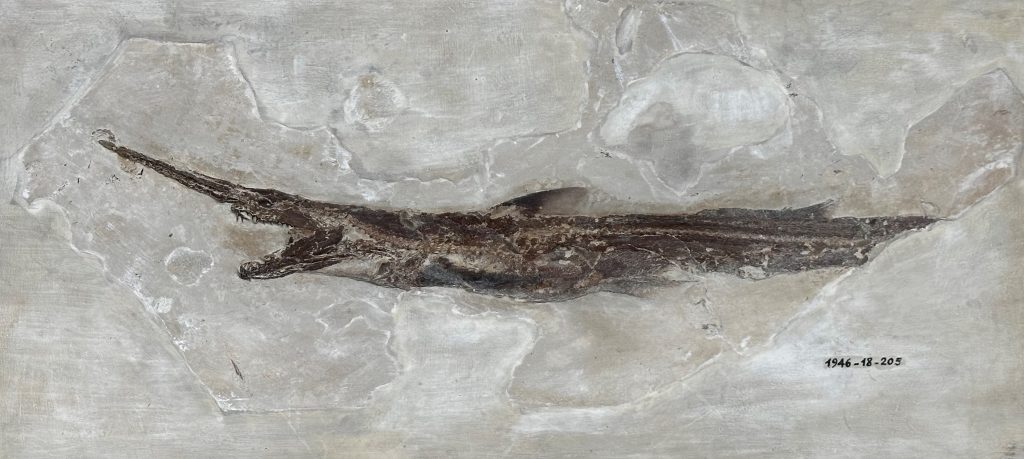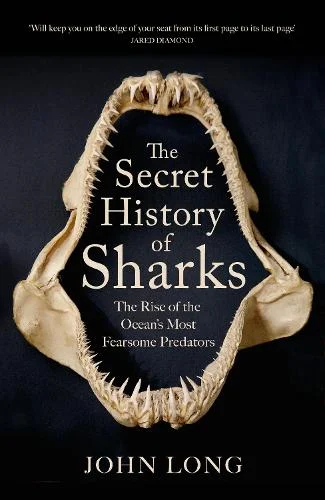PROTECT YOUR DNA WITH QUANTUM TECHNOLOGY
Orgo-Life the new way to the future Advertising by Adpathway
Published on August 9th, 2025 | by Hady George
For approximately 450 million years, sharks and their cartilaginous relatives have been a major hallmark of marine life. Withstanding multiple cataclysmic events, most notably those at the end of the Permian and Cretaceous, and maintaining a great diversity in today’s oceans, the evolutionary history of sharks is a lengthy, gripping tale of one of the most successful vertebrate lineages. Despite the monumental amount of research into the evolution of sharks through deep time led by scientists across the globe, there is a scarcity of popular science pieces synthesising the great number of modern fossil-related discoveries and packaging them for a lay audience to connect with and enjoy. The recently released The Secret History of Sharks: The Rise of the Ocean’s Most Fearsome Predators by palaeontologist Professor John Long of Flinders University, Adelaide, Australia fills in this gap in the popular science literature with its wonderful overview of shark evolution, from their origins as armoured fish in the Devonian to the whites and hammerheads currently on the prowl. Overall, I believe this work has three main strengths that justify recommending it to any enthusiast of sharks, palaeontology, or evolutionary biology more widely.
 A megalodon (Otodus megalodon) fossil tooth (right) and a white shark (Carcharodon carcharias) subfossil tooh in the average-sized hand of Hady George at the fossil fish collections of the Natural History Museum, London, UK. Photo by Hady George
A megalodon (Otodus megalodon) fossil tooth (right) and a white shark (Carcharodon carcharias) subfossil tooh in the average-sized hand of Hady George at the fossil fish collections of the Natural History Museum, London, UK. Photo by Hady GeorgeArguably the most important feat of this book is that it accomplishes the main task it sets out to do: overviewing a large number of recent and historical discoveries that collectively reveal the journey sharks (technically, cartilaginous fishes) have been on for almost half a billion years. One of my favourites was the identification of relatively large olfactory bulbs in the Early Devonian Doliodus through CT-scanning, indicating that even early on in their evolution, the ancestors of sharks had likely already evolved the powerful sense of smell we associate with them today. Others include the unveiling of the Late Cretaceous “manta-shark” Aquilolamna in 2021 and evidence for sixgill sharks scavenging Otodus angustidens – a close relative of megalodon- in the Oligocene. Beyond discoveries concerning fossil sharks, the final Part of the book highlights various discoveries surrounding modern sharks, in particular white sharks. While an ambitious amount of content is described throughout this book, it can somewhat leave the reader wanting more. Personally, I would have liked to have seen more on the Lebanese Cretaceous sharks, especially the charismatic fossil goblin sharks. Likewise, some information on how living chimaera (also known as ghost sharks and rat fish) survive at such great depths and what they prey on would be of value to a reader unfamiliar with them.
 A goblin shark relative (Scapanorhynchus) from the Cretaceous of Lebanon, and on display at Muséum national d’histoire naturelle, Paris, France. Photo by Hady George
A goblin shark relative (Scapanorhynchus) from the Cretaceous of Lebanon, and on display at Muséum national d’histoire naturelle, Paris, France. Photo by Hady GeorgeBeyond the deep dive into the evolutionary history of sharks, the book also covers much of the fascinating connection we have had with sharks for thousands of years. It was fascinating to learn about how North American First Nations peoples used megalodon teeth as cutting tools and how Late Medieval European nobles believed they could detect poison in their drinks by dunking a fossil shark tooth. The human connection is not restricted solely to cultural links and practical use, but is also expressed as scientific discovery. Many of the adventures and exploits of scientists both historic and modern are highlights of this book. One such adventure, told from the author’s perspective while fossil hunting in the Antarctic, is the riveting opening of the very first chapter, and had me eagerly flipping through the first few pages. Another that made for one of the funnier moments was the encounter the author and colleague Mikael Siversson had with a flock of emus in the Australian outback. Some might argue that the inclusion of perilous tales of fieldwork to hook readers have become too common among the current popular palaeo-literature (or even the historic literature too), but in this case, it is refreshing to see such tales specifically focus on the discovery of fossil sharks and their relatives. Furthermore, the fieldwork adventures are not restricted to any one place but are instead almost all over the world.
The third major strength of this book is how it uses the fossil record of sharks as a tool for describing key principles in evolutionary biology as well as how we as palaeontologists make sense of the fossils we find. For example, anagenesis is explained through the evolutionary sequence of megatooth shark species, where teeth gradually became more serrated and larger, culminating in the iconic megalodon. Some of the insight into palaeontological practices that the general public might find interesting include how we can identify if a coprolite originally came from a shark based on whether it has a spiral-shape, and how we can use synchrotron scanning to take a look at the brain of a 300-million-year-old shark relative. These primers into how we discover and reconstruct the evolutionary history of sharks are not only explained through text and informative figures (whether they be photos of fossils or diagrams) but also through key terms that are in bold type and have definitions listed in the glossary at the end of the book. Most of these terms relate to specific clades or informal groups of sharks and many other organisms that have existed alongside them like plesiosaurs, while other terms relate to important biological concepts ranging from homeobox genes to trophic ecology.
My only noteworthy gripes with the book largely concern editorial decisions. Among my criticisms is that some of the language here and there felt a bit jarring to read. This relates to the use of certain phrases that are arguably too colloquial, such as ‘got the hell out of dodge’ and ‘an IMAX view of life of the past’. The reading experience would have been enhanced if the editing was focused more on tightening language as well as providing more room for the author to elaborate on fossil sharks and their history of discovery. Another issue I had was the lack of coloured artwork (although this could change in future editions). Julius Csotonyi’s artwork throughout the book is spectacular and brings to life a huge range of sharks and relatives, many of which are superbly bizarre and thought-provoking. Such artwork plays a huge role in shaping the general public’s imagination of these bygone animals, and so it is a shame to not see at least some of the art in colour. The same criticism also applies to the greyscale photographs of many of the figured fossils, particularly those from Lagerstätten, as the beauty of their exceptional preservation is harder to appreciate without colour.
Despite my criticisms, I genuinely believe The Secret History of Sharks is one of my top recommendations for anyone who is a fan of sharks, fossils, or the evolution of life across a huge timeframe. The vast majority of popular palaeo-science books that have become modern staples of the subgenre primarily concern dinosaurs and many others centre around other tetrapods. Even those about ancient marine life focus predominantly on secondarily aquatic marine tetrapods. This is not a criticism of such works, but instead highlights that The Secret History of Sharks fills an important gap in the popular literature, hence why I strongly recommend it. I think any reader will walk away from this book having learnt something new and exciting, whether it be about some weird extinct fish with cartilage for a skeleton, the daring quests palaeontologists will brave to forage for fossils, or how the shark fossil record provides wonderful insight into evolutionary theory.
Hady George is a palaeontology PhD student at the University of Bristol researching jaw function across the fish-tetrapod transition among other things, and seemingly always has a pop science book somewhere.
Cover image: cover of the hardcover edition published by Quercus Publishing


 15 hours ago
8
15 hours ago
8























 English (US) ·
English (US) ·  French (CA) ·
French (CA) ·